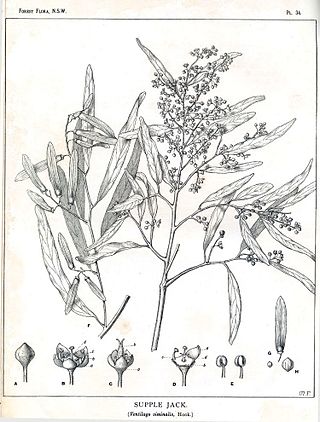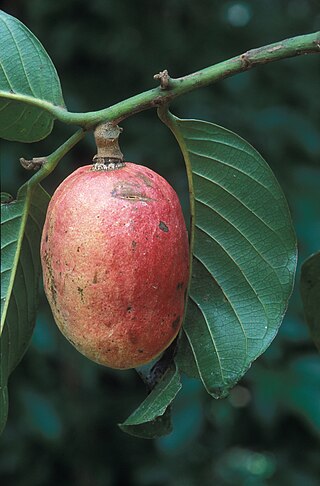
The Annonaceae are a family of flowering plants consisting of trees, shrubs, or rarely lianas commonly known as the custard apple family or soursop family. With 108 accepted genera and about 2400 known species, it is the largest family in the Magnoliales. Several genera produce edible fruit, most notably Annona, Anonidium, Asimina, Rollinia, and Uvaria. Its type genus is Annona. The family is concentrated in the tropics, with few species found in temperate regions. About 900 species are Neotropical, 450 are Afrotropical, and the remaining are Indomalayan.

Mitrephora is a genus of flowering plants in the family Annonaceae, that are native to an area that extends from China in the north to Queensland. Plants in the genus Mitrephora are also found in southern India and Southeast Asia.

Dysoxylum is a genus of rainforest trees and shrubs in the flowering plant family Meliaceae. About 34 species are recognised in the genus, distributed from India and southern China, through southeast Asia to New Guinea, Solomon Islands, and Australia. The name Dysoxylum derives from the Greek word ‘Dys’ meaning "bad" referring to "ill-smelling" and ‘Xylon’ meaning "wood".

Goniothalamus is one of the largest palaeotropical genera of plant in family Annonaceae.

Phaeanthus is a genus of plant in family Annonaceae.

Polyalthia is a genus of flowering plants in the family Annonaceae. There are approximately 90 species distributed from Africa to Asia and the Pacific.

Pseuduvaria is a genus of the plant family Annonaceae and tribe Miliuseae: with a native range is Tropical Asia.

Ventilago is a genus of plants in the family Rhamnaceae. It includes about 40 species found in the tropics of South and SE Asia, Australasia, with one species each in Africa and Madagascar.

Cyathocalyx is a small genus with about 22 species distributed from southern India, Sri Lanka, through Malaysia, Indomalayan islands and reaches as far as Fiji in the South Pacific.

Artabotrys is a genus of plants in the Annonaceae family. There are over 100 species in the Old World tropics, with 31 species in Africa. It is part of the custard apple family (Annonaceae). All species are small trees or shrubs with a tendency to climb. Leaves are simple and alternate, without hairs. Bisexual flowers are borne singly or in clusters opposite the leaves. The 6-petalled flowers are scented, and the plant bears fleshy fruits.
Meiogyne laddiana is a species of plant in the family Annonaceae, first described by Albert Charles Smith in 1936 as Polyalthia laddiana. It is endemic to Fiji.

Huberantha is a genus of plants in the family Annonaceae and tribe Miliuseae. It is distributed in Australia, tropical Asia, East Africa and some Pacific islands. Tanawat Chaowasku named the genus "Huber's flowers" in honor of the German botanist Herbert Huber and to highlight its flowers as a distinguishing feature of the genus. A number of species have been moved here from the genus Polyalthia.

Monoon is a genus of plants in the family Annonaceae and the tribe Miliuseae. Species have been recorded from the Indian subcontinent, Indo-China, Malesia, New Guinea and Australia, with introductions in West Africa. A number of species have been moved here from the genus Polyalthia.

The Malmeoideae are a subfamily of trees and other plants of the family Annonaceae.

Friesodielsia is a genus of flowering plants in the custard apple and soursop family Annonaceae, with all species found in the Old World, mostly in the tropics. A molecular study shows that Friesodielsia should be more narrowly circumscribed, with the only species remaining being the Asian ones, which can also be distinguished by their possession of globose or ellipsoid monocarps, and six petals per flower arranged in two whorls.

Dasymaschalon is an Asian genus of bushy plants in the subfamily Annonoideae and tribe Uvarieae. Its native range is from southern China, Indo-China to Malesia.
Drepananthus is a genus of flowering plants belonging to the family Annonaceae.















